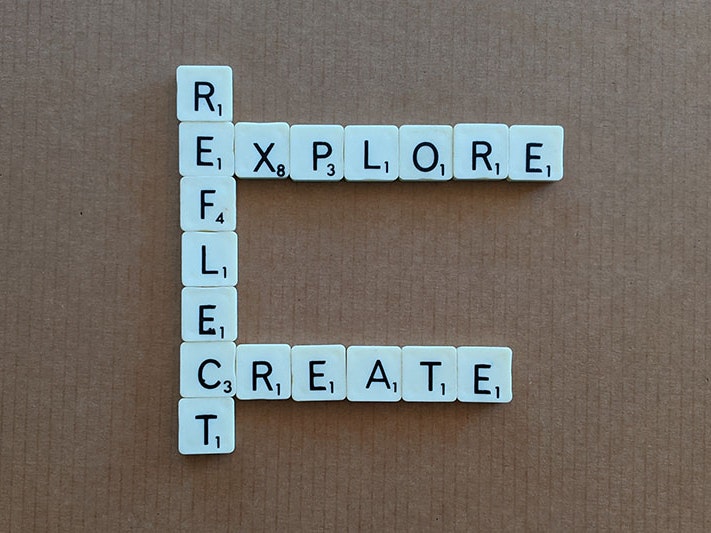
Introduction
Read an introduction to this learning resource, and the artwork that inspired it.
Free museum entry for New Zealanders and people living in New Zealand
Open every day 10am-6pm
(except Christmas Day)
Free museum entry for New Zealanders and people living in New Zealand
This resource weaves together learning areas from the NZC, using high impact practices within local curriculum, such as developing community relationships for learning.
From the Past, for Tomorrow explores two cross-curricular themes that show up within Visual Arts, Aotearoa New Zealand (ANZ) Histories, Technology, and Health and PE in differing ways.
Who we are, and who gets to tell the stories of who we are.
This theme focuses learners on the subjective nature of representation – and how values, attitudes, and beliefs impact on how identity is communicated to others. Learners explore the ways in which costume and adornment can communicate identity, and consider the ways in which their developing identity is expressed. They consider the power of storytelling and the ways in which we can ensure it is authentic.
Learners look at the ways in which art and technology can be used as tools to respond, redress, and retell history. They consider and then respond to the motivations and purpose of the artist Lisa Reihana’s work as a reaction to the colonial lens.
How things were, how things are, and how things could be next.
This theme creates opportunities for learners to examine time, continuity, and change in relation to their local context. Learners are encouraged to not only identify ways in which life has changed over time, but to also consider the ways in which history changes over time. This theme also creates opportunities for learners to positively contribute to their community, encouraging both teachers and learners to be agentic changemakers in connection with their community.
This theme also shows up in the examinations of past and contemporary art practice. Learners can explore static and moving images to begin to understand some of the very real challenges and opportunities of creating art using today’s technologies, such as time-based media.
This resource links the principles, values, and key competencies of the NZC with parts of the Visual Arts, ANZ Histories, Technology, and Health and PE learning areas through a smorgasbord of rich tasks.
The integrated inquiry model is assumed to be of most relevance to teachers of learners between Years 4–10. With this in mind, the following curriculum links have been made at Level 3 and Level 4 of the NZC.
Through Reihana’s artwork, ākonga can value and understand multiple perspectives on historical and contemporary events, and develop their critical thinking and inquiry skills – understanding the past to make sense of the present and inform future decisions and actions.
The threads below are woven together for meaningful, rich learning experiences, as described within the ANZ Histories curriculum [PDF, 459 KB].
|
Understand |
Understand one big idea Colonisation and its consequences have been central to our history for the past 200 years and continue to influence all aspects of New Zealand society. | |
|
European explorers’ encounters in the Pacific, which are the focus of Reihana’s artwork in Pursuit of Venus [infected], took place within the worldwide imperial project that preceded the colonisation of Aotearoa. in Pursuit of Venus [infected] responds to these events by challenging the dominant historical narrative that was recorded at that time, and centring multiple Pacific experiences rather than those of the explorers. In returning the point of view on the Pacific encounter histories to the Pacific communities themselves, Reihana reverse maps the impact of colonisation on the Pacific. Using the resource, teachers and learners explore this big idea by analysing the power associated with history and the politics of storytelling, identity, and representation. They consider the ways in which they can redress imbalances in their local history, decentring dominant narratives to create space for agency, reconciliation, and healing. | ||
| Know |
Turangawaewae me te kaitiakitanga This context focuses on the relationships of individuals, groups, and communities with the land, water, and resources, and on the history of contests over their control, use, and protection. | |
| This resource creates the space for teachers and learners to consider some of the differences that exist between tangata moana, tangata whenua, and tangata tiriti relationships to the land, water, and resources, by engaging with their own place-based histories in response to Reihana’s artwork. Rohe and local contexts are explored through local, place-based approaches. | ||
| Year 4–6 | Year 7–8 | Year 9–10 |
|
Land, water, and resources Over the course of time, people have changed and been changed by the environment. These changes were governed by different values and cultures that sometimes coincided and sometimes clashed. |
Land, water, and resources Aotearoa New Zealand was claimed and named. Te taiao was cared for and transformed by Māori and by subsequent settlers. Mana motuhake Mana was central to all political and economic relationships in traditional Māori society and has continued to shape internal and external interactions. |
Land, water, and resources There have been contested views about developing Aotearoa New Zealand and its economic resources. This is especially evidenced by our environmental history. |
| Do |
Identifying and using sequence The construction of narratives about the past is based on the ability to identify relationships between events and to make connections with the present. Depending on the frame of reference used in sequencing, the same story can be told in different ways. | |
| This can be directly explored through considering Dufour and Reihana’s understandings and approaches to the same places and periods of time. (Joseph Dufour was the French colonial-era entrepreneur whose wallpaper designs inspired Reihana.) It can also be addressed through localised examinations of the ways in which different frames of reference contribute to differing stories. | ||
| Year 4–6 | Year 7–8 | Year 9–10 |
|
I can construct an historical sequence of related events and changes and recognise that others might sequence it differently. |
I can construct an extended historical sequence of related events and changes, locate it in relation to the present, and recognise that others might sequence it differently using a different frame of reference. |
I can construct and compare narratives of cause and consequence that place historical events, people, and changes in an extended sequence with links to the present. |
| Do |
Identifying and critiquing sources and perspectives Drawing on a broad base of historical sources, in varied forms, provides a fuller and layered understanding of the past. This includes paying deliberate attention to mātauranga Māori sources and approaches. Considering authorship and identifying missing voices – and where they might be found – are ways of critiquing sources. | |
| This inquiry practice will be cultivated in local community contexts. Learners can use Reihana’s approaches to in Pursuit of Venus [infected] to think about, and actively respond to, local, place-based histories. | ||
| Year 4–6 | Year 7–8 | Year 9–10 |
|
I can draw on historical sources, giving deliberate attention to mātauranga Māori sources, to answer questions about the past. While doing so, I identify views that are missing and note how this restricts my conclusions. |
I can actively seek out historical sources with differing perspectives on the past, giving deliberate attention to mātauranga Māori sources. While doing so, I recognise that sources are incomplete, that there may not be a full answer to questions, and that my conclusions are themselves interpretations. |
I can actively seek out historical sources with differing perspectives and contrary views (including those that challenge my own interpretation), giving deliberate attention to mātauranga Māori sources. While doing so, I identify missing voices and draw conclusions that capture the diversity of people’s experiences. |
| Do |
Interpreting past decisions and actions Interpretations of people’s past decisions and actions need to take account of the attitudes and values of the time and people’s predicaments and points of view. By acknowledging the benefits of hindsight and reflecting on our own values, we can make ethical judgements concerning right and wrong. | |
| This inquiry practice explores the context of Dufour’s panels, as well as local histories. Reihana’s response can be seen as an active dialogue with the ways in which Pacific peoples were represented within the encounter world of Cooks’ voyages. By using Te Papa’s collections, there is also room in this inquiry to examine the attitudes and values that underpinned traditional museology and the contemporary challenges of decolonising these museum practices. | ||
| Year 4–6 | Year 7–8 | Year 9–10 |
|
I can identify the attitudes and values that motivated people in the past and compare them with attitudes and values of today. |
I can make an informed ethical judgement about people’s actions in the past, taking account of the attitudes and values of the times and the challenges people faced. |
I can make an informed ethical judgement about people’s actions in the past, giving careful consideration to the complex predicaments they faced, the attitudes and values of the times, and my own values and attitudes. |
| Understand |
Understanding the visual arts in context Investigate the purpose of objects and images from past and present cultures and identify the contexts in which they were or are made, viewed, and valued. (L4) | |
| This resource encourages learners to see art as a reflection of attitudes, values, and beliefs – which may represent the individual artist and also the time within which the artwork was made. | ||
| Do |
Developing ideas Develop and revisit visual ideas, in response to a variety of motivations, observation, and imagination, supported by the study of artists’ works. (L4) | |
|
Developing practical knowledge Explore and use art-making conventions, applying knowledge of elements and selected principles through the use of materials and processes. (L4) | ||
|
Communicating and interpreting Explore and describe ways in which meanings can be communicated and interpreted in their own and others’ work. (L4) | ||
| Learners are encouraged to develop their own artistic responses that riff from artists’ work, play with art-making conventions, and communicate meaning within and from their own worlds. | ||
| Know |
Nature of technology Understand how technological development | |
|
Characteristics of technological outcomes Understand that technological outcomes can be interpreted in terms of how they might be used and by whom and that each has a proper function as well as possible alternative functions. (L4) | ||
| Learners can compare and contrast the ways in which artists of the past and contemporary artists use technology to communicate ideas, including the use of time-based media, such as that used by Reihana. | ||
| Do |
Technological practice Undertake planning to identify the key stages and resources required to develop an outcome. Revisit planning to include reviews of progress and identify implications for subsequent decision making. (L3) | |
|
Brief development Describe the nature of an intended outcome, explaining how it addresses the need or opportunity. Describe the key attributes that enable development and evaluation of an outcome. (L3) | ||
|
Outcome development and evaluation Investigate a context to develop ideas for potential outcomes. Trial and evaluate these against key attributes to select and develop an outcome to address the need or opportunity. Evaluate this outcome against the key attributes and how it addresses the need or opportunity. (L3) | ||
| This inquiry guides learners to develop their own creative responses, and through this learners plan for, develop, and review their processes and their successes using digital tools to bring their vision to life. | ||
| Know |
Personal health and physical development Describe how their own feelings, beliefs, and actions, and those of other people, contribute to their personal sense of self-worth. (L3) Describe how social messages and stereotypes, including those in the media, can affect feelings of self-worth. (L4) | |
| This inquiry can explore the ways in which popular culture provides strong social messages that can impact on how good we feel about ourselves. Learners are encouraged to consider their own identity and to develop ways in which this can be expressed that contribute to their sense of worth and celebrate their potential. | ||
| Do |
Relationships with other people Recognise instances of discrimination and act responsibly to support their own rights and feelings and those of other people. (L4) | |
| This inquiry could lead learners to critically analyse issues of diversity, discrimination, and representation, particularly within popular culture, and to find ways to respond to these issues. | ||

Read an introduction to this learning resource, and the artwork that inspired it.

From the Past, for Tomorrow offers place-based, learner-led approaches that give life to the front end of The New Zealand Curriculum.

This resource uses two main inquiry arcs – a content-rich exploration, and then in response, active learner-led creation. Reflective activities are integrated throughout.